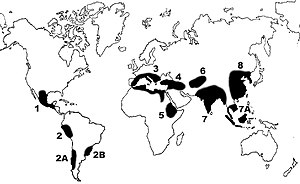OGIGIN OF CULTIVATED PLANTS
A center of origin (or centre of diversity) is a geographical area where a group of organisms, either domesticated or wild, first developed its distinctive properties. Centers of origin are also considered centers of diversity. Nikolai Vavilov initially identified 8 of these, later subdividing them into 12 in 1935.
Plants
Locating the origin of crop plants is basic to plant breeding. This allows one to locate wild relatives, related species, and new genes (especially dominant genes, which may provide resistance to diseases). Knowledge of the origins of crop plants is important in order to avoid genetic erosion, the loss of germplasm due to the loss of ecotypes and landraces, loss of habitat (such as rainforests), and increased urbanization. Germplasm preservation is accomplished through gene banks (largely seed collections but now frozen stem sections) and preservation of natural habitats (especially in centers of origin).
Vavilov centers
A Vavilov Center (of Diversity) is a region of the world first indicated by Nikolai Vavilov to be an original center for the domestication of plants.
Vavilov developed a theory on the centers of origin of cultivated plants. He stated that plants were not domesticated somewhere in the world at random but there are regions where the domestication started. The center of origin is also considered the center of diversity.
Vavilov developed a theory on the centers of origin of cultivated plants. He stated that plants were not domesticated somewhere in the world at random but there are regions where the domestication started. The center of origin is also considered the center of diversity.
Vavilov centers are regions where a high diversity of crop wild relatives can be found, representing the natural relatives of domesticated crop plants. Later in 1935 Vavilov divided the centers into 12, giving the following list:
- Chinese center
- Indian(Hindustan) center
- Indo-Malayan center
- Central Asiatic center
- Persian center
- Mediterranean center
- Abyssinian center
- South American center
- Central American center
- Chilean center
- Brazilian center
- North American center
- World centers of origin of cultivated plant
Center Plants 1) South Mexican and Central American Center Includes southern sections of Mexico, Guatemala, Honduras and Costa Rica. - Grains and Legumes: maize, common bean, lima bean, tepary bean, jack bean, grain amaranth
- Melon Plants: malabar gourd, winter pumpkin, chayote
- Fiber Plants: upland cotton, bourbon cotton, henequen (sisal)
- Miscellaneous: sweetpotato, arrowroot, pepper, papaya, guava, cashew, wild black cherry, chochenial, cherry tomato, cacao.
2) South American Center 62 plants listed; three subcenters 2) Peruvian, Ecuadorean, Bolivian Center:- Root Tubers: Andean potato, Other endemic cultivated potato species. Fourteen or more species with chromosome numbers varying from 24 to 60, Edible nasturtium
- Grains and Legumes: starchy maize, lima bean, common bean
- Root Tubers: edible canna, potato
- Vegetable Crops: pepino, tomato, ground cherry, pumpkin, pepper
- Fiber Plants: Egyptian cotton
- Fruit and Miscellaneous: cocoa, passion flower, guava, heilborn, quinine tree, tobacco, cherimoya, coca
2A) Chiloe Center (Island near the coast of southern Chile)- Common potato (48 chromosomes), Chilean strawberry
2B) Brazilian-Paraguayan Center- manioc, peanut, rubber tree, pineapple, Brazil nut, cashew, Erva-mate, purple granadilla.
3) Mediterranean Center Includes the borders of the Mediterranean Sea. 84 listed plants - Cereals and Legumes: durum wheat, emmer, Polish wheat, spelt, Mediterranean oats, sand oats, canarygrass, grass pea, pea, lupine
- Forage Plants: Egyptian clover, white clover, crimson clover, serradella
- Oil and Fiber Plants: flax, rape, black mustard, olive
- Vegetables: garden beet, cabbage, turnip, lettuce, asparagus, celery, chicory, parsnip, rhubarb,
- Ethereal Oil and Spice Plants: caraway, anise, thyme, peppermint, sage, hop.
4) Middle East Includes interior of Asia Minor, all of Transcaucasia, Iran, and the highlands of Turkmenistan. 83 species - Grains and Legumes: einkorn wheat, durum wheat, poulard wheat, common wheat, oriental wheat, Persian wheat, two-row barley, rye, Mediterranean oats, common oats, lentil, lupine
- Forage Plants: alfalfa, Persian clover, fenugreek, vetch, hairy vetch
- Fruits: fig, pomegranate, apple, pear, quince, cherry, hawthorn.
5) Ethiopia Includes Abyssinia, Eritrea, and part of Somaliland. 38 species listed; rich in wheat and barley. - Grains and Legumes: Abyssinian hard wheat, poulard wheat, emmer, Polish wheat, barley, grain sorghum, pearl millet, African millet, cowpea, flax, teff
- Miscellaneous: sesame, castor bean, garden cress, coffee, okra, myrrh, indigo.
6) Central Asiatic Center Includes Northwest India (Punjab, Northwest Frontier Provinces and Kashmir), Afghanistan, Tadjikistan, Uzbekistan, and western Tian-Shan. 43 plants - Grains and Legumes: common wheat, club wheat, shot wheat, peas, lentil, horse bean, chickpea, mung bean, mustard, flax, sesame
- Fiber Plants: hemp, cotton
- Vegetables: onion, garlic, spinach, carrot
- Fruits: pistacio, pear, almond, grape, apple.
7) Indian Center Two subcenters 7) Indo-Burma: Main Center (India): Includes Assam and Burma, but not Northwest India, Punjab, nor Northwest Frontier Provinces, 117 plants- Cereals and Legumes: rice, chickpea, pigeon pea, urd bean, mung bean, rice bean, cowpea,
- Vegetables and Tubers: eggplant, cucumber, radish, taro, yam
- Fruits: mango, orange, tangerine, citron, tamarind
- Sugar, Oil, and Fiber Plants: sugar cane, coconut palm, sesame, safflower, tree cotton, oriental cotton, jute, crotalaria, kenaf
- Spices, Stimulants, Dyes, and Miscellaneous: hemp, black pepper, gum arabic, sandalwood, indigo, cinnamon tree, croton, bamboo.
7A) Siam-Malaya-Java: statt Indo-Malayan Center: Includes Indo-China and the Malay Archipelago, 55 plants- Cereals and Legumes: Job's tears, velvet bean
- Fruits: pummelo, banana, breadfruit, mangosteen
- Oil, Sugar, Spice, and Fiber Plants: candlenut, coconut palm, sugarcane, clove, nutmeg, black pepper, manila hemp.
8) Chinese Center A total of 136 endemic plants are listed in the largest independent center - Cereals and Legumes: e.g. broomcorn millet, Italian millet, Japanese barnyard millet, Koaliang, buckwheat, hull-less barley, soybean, Adzuki bean, velvet bean
- Roots, Tubers, and Vegetables: e.g. Chinese yam, radish, Chinese cabbage, onion, cucumber
- Fruits and Nuts: e.g. pear, Chinese apple, peach, apricot, cherry, walnut, litchi
- Sugar, Drug, and Fiber Plants: e.g.sugar cane, opium poppy, ginseng camphor, hemp.

No comments:
Post a Comment